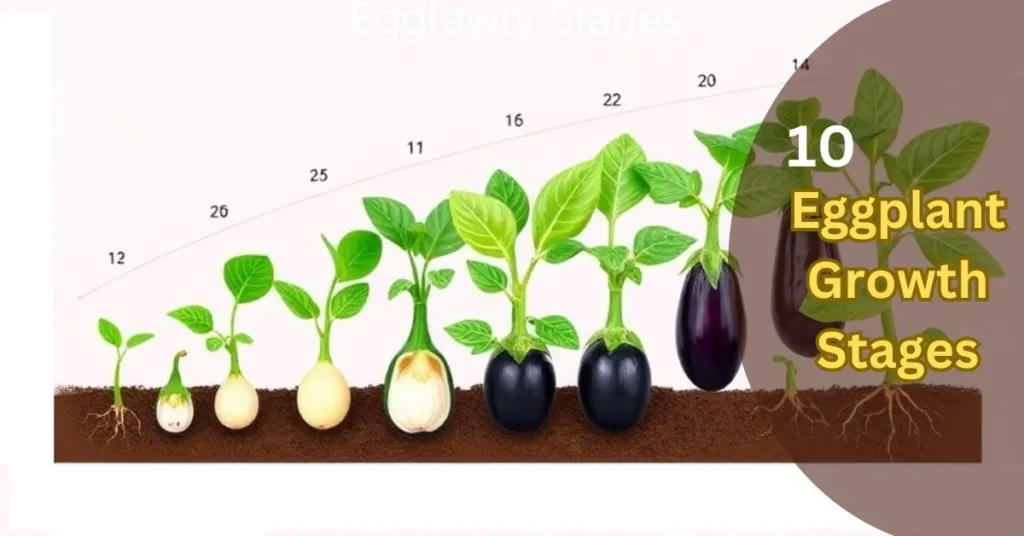Cherry tomatoes are a favorite among gardeners and home growers for their sweet, petite size and delicious fruit. To ensure a successful growing experience, understanding the growth habits of these plants is essential. They grow best in a bountiful environment with the right balance of light and space.
Whether you’re growing them indoors or outdoors, these plants require specific light requirements and a well-managed growing area to thrive. The root depth is particularly important for ensuring that the plants are strong and capable of supporting the weight of their vibrant fruit.
When it comes to growth, the size of cherry tomato plants varies depending on the care they receive. They have a moderate growth duration, and understanding this will help you plan for a timely harvest.
Common questions about cherry tomatoes usually revolve around their ideal growing conditions, including how to manage their space indoors and outdoors. Providing the right guide for their care can make all the difference in achieving a successful, bountiful harvest of cherry tomato plants. These aspects of care lead to a flourishing garden full of vibrant, tasty fruit.
Key Points
| Aspect | Details |
|---|---|
| Scientific Name | Solanum lycopersicum var. cerasiforme |
| Plant Type | Annual (in most climates) |
| Growth Habit | Determinate (bush-type) or indeterminate (vining type) |
| Plant Height | 3-10 feet (depending on the variety) |
| Fruit Size | Small, round, typically 1–2 inches in diameter |
| Fruit Color | Red, yellow, orange, black, or green (depending on the variety) |
| Sunlight Requirement | Full sun (6–8 hours of direct sunlight daily) |
| Soil Type | Well-draining, nutrient-rich soil |
| Soil pH | 6.0–6.8 |
| Watering Needs | Regular watering, 1–2 inches per week; avoid waterlogging |
| Fertilizer Needs | Balanced fertilizer (e.g., 10-10-10) applied every 2–4 weeks |
| Temperature Range | 70–85°F (21–29°C) optimal for growth |
| Plant Spacing | 24–36 inches apart for proper air circulation |
| Support Needed | Stakes, cages, or trellises for vining varieties |
| Harvest Time | 65–80 days after planting (varies by variety) |
| Common Pests | Aphids, whiteflies, hornworms, spider mites |
| Common Diseases | Blight, mosaic virus, powdery mildew |
| Propagation Method | Seeds or seedlings |
| Companion Plants | Basil, marigold, garlic, carrots, onions |
| Toxicity | The ingestion of leaves and stems poses a toxic risk to both humans and pets. |
| Special Care Tips | Prune suckers for better airflow and higher yield |
How Tall Do Cherry Tomato Plants Grow?
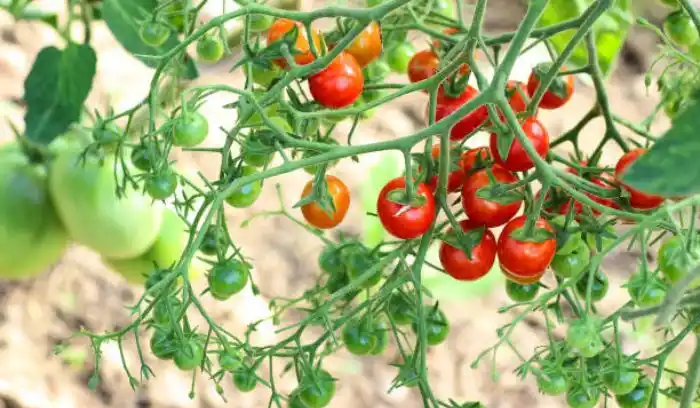
When growing cherry tomato plants, one thing is certain – their height can vary significantly based on the variety. On average, you can expect them to grow to about 6 feet to 8 feet (1.8 meters to 2.4 meters).
However, depending on the type of plant, their growth can be more compact or tall. For example, determinate varieties are typically shorter, growing to around 3 feet to 4 feet (0.9 meters to 1.2 meters), while indeterminate types tend to grow much more, often surpassing the average height of 6 feet or more.
To ensure healthy and sturdy growth, it’s important to provide adequate support. Using structures like stakes or cages can make a significant difference, especially if you’re aiming to control the plant’s height.
Pruning also plays a key role in encouraging better growth, as it helps to direct the energy to the right parts of the plant, giving you the best possible harvest. The use of these support systems is highly recommended for anyone looking to grow their cherry tomato plants effectively.
How Long Do Cherry Tomato Plants Take to Grow?
The time it takes for cherry tomato plants to grow and reach maturity can vary based on a few different factors. The variety of the plant and the growing conditions play a significant role in how quickly it matures.
n general, once transplanted, it takes about 50 days to 85 days for the plants to reach full maturity. However, if you start from seed, it can take an additional 6 weeks to 8 weeks because seed germination itself takes this amount of time.
If you’re eager to enjoy ripe fruit sooner, you might want to consider choosing early-maturing cherry tomato varieties. These types can help you harvest your tomatoes more quickly, speeding up the entire growing process from seed to the table. I’ve found that with the right variety and care, you can expect a faster harvest and a better overall result.
Can You Grow Cherry Tomatoes Indoors?
Yes, you absolutely can grow cherry tomatoes indoors, making them a perfect option for apartment dwellers or anyone with limited outdoor space. All you need is a sunny location where your plants can get 6-8 hours of direct sunlight each day. If that’s not possible, grow lights work wonders to provide the light your plants need.
Choosing the right container or grow bag with good drainage is crucial to prevent waterlogging. A high-quality potting mix will give your plants the nutrients they need for satisfying growth.
When growing cherry tomatoes indoors, proper care and regular maintenance are essential. Be sure to provide adequate watering and fertilization to support healthy plant development.
If you’re growing indeterminate varieties, they might need a little extra attention due to their continual growth. Keep in mind that indoor plants may not grow as large as their outdoor counterparts, but with the right setup, you can still enjoy a bountiful harvest of fresh, homegrown tomatoes.
How Deep Do Cherry Tomato Roots Grow?

The depth of cherry tomato roots largely depends on the conditions of the soil and the water availability. In loose soil that is well-draining, the roots can extend up to 2-3 feet (around 0.6 to 0.9 meters), allowing the plant to reach adequate nutrients.
When growing in a container or garden bed, the roots adapt to the available space, which is why it’s important to choose the right size container or bed for proper root development.
For optimal growth, providing sufficient soil depth and ensuring consistent moisture is essential. If you use grow bags, the root system will adapt to the available space and continue to thrive. With proper care, these roots can develop into a healthy, strong foundation for your cherry tomatoes, leading to better overall plant health and higher yields.
Can Cherry Tomatoes Grow in the Shade?
Cherry tomatoes grow best in full sun, which helps them thrive. Ideally, they need a location with 6-8 hours of direct sunlight each day. However, they can tolerate partial shade, especially in regions that experience hot summers. If your space doesn’t get enough sun, you can still grow them successfully by choosing specific cherry tomato varieties known for shade tolerance.
To get the best results in limited sunlight, place your plants where they can catch morning sun, which is less intense than afternoon sun. You can also use reflective surfaces to redirect and maximize available sunlight.
Regularly prune your plants to improve air circulation, which helps the remaining foliage get more light. While cherry tomatoes can survive in some shade, they will produce the best yields when placed in sunny locations.
Related Post: How To Tell If A Tomato Has Gone Bad – A Beginner’s Guide
Do Cherry Tomato Plants Require Pruning?
Pruning cherry tomato plants is optional, but it can definitely be beneficial for their overall health and productivity. By pruning, you can improve air circulation, which helps reduce the risk of disease.
It also helps direct the plant’s energy toward fruit production instead of foliage growth. Pruning is especially useful when you want to control the size of the plant, particularly with indeterminate varieties that tend to grow larger and more unruly.
Common pruning techniques include removing lower leaves and cutting off suckers—the small shoots that grow in the leaf axils. These simple steps can make a big difference in how well the plant grows and produces fruit. Ultimately, pruning is a matter of personal preference, and it depends on the specific needs of your garden.
Can Cherry Tomato Plants Be Grown in Containers or Grow Bags?

If you have limited outdoor space, growing cherry tomato plants in containers or grow bags is an excellent choice. These plants can thrive in smaller spaces as long as they have enough space for root development.
A container or grow bag that holds at least 5 gallons of high-quality potting mix with good drainage will provide the best environment for your plants. Be sure to also add support structures like stakes or cages to help the plants stay upright as they grow.
In container gardening, you’ll need to monitor the watering closely because containers and grow bags can dry out more quickly than regular garden soil. It’s also important to fertilize the plants regularly to provide them with essential nutrients.
Understanding the growth habits and specific needs of your plants can help ensure a successful and productive harvest of delectable fruits, whether you’re growing them on a sunny balcony or indoors.
Can I Grow Cherry Tomato In Pots
Cherry tomatoes are a great option for container gardening, making them a popular choice for growing on balconies or patios. These plants are known for their compact size, yet they can provide a high yield when properly cared for.
The key to success is choosing the right pot size, typically a pot with a diameter of at least 12 inches. Be sure to use a quality potting mix that is well-draining to keep your plants healthy.
When growing vining plants like cherry tomatoes, it’s important to provide support. A stake or trellis will help keep the plant upright and thriving. These tomatoes need at least 6 hours of direct sunlight daily, so place your pot in a sunny location.
Consistent watering is also essential; the soil should be consistently moist but avoid overwatering. Finally, use a balanced liquid fertilizer throughout the growing season to encourage strong growth and good fruit production.
Harvesting Cherry Tomatoes
Cherry tomatoes are ready to harvest when they are firm, bright red, and about one to two inches long. To harvest them, you can gently grasp the tomato and twist off the vine.
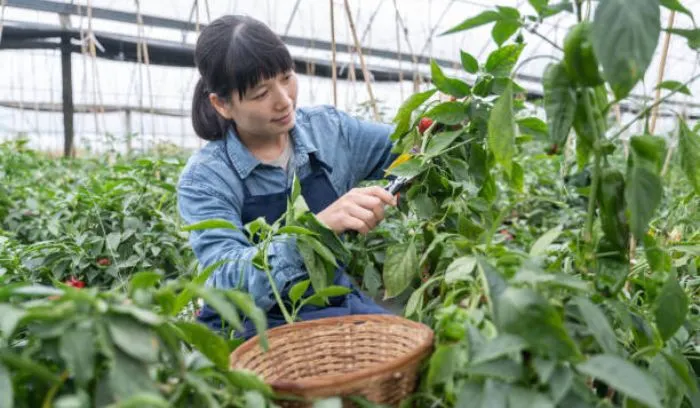
Look for tomatoes that are a glossy red in color, and make sure they feel firm to the touch. It’s important to pick them often to encourage more fruit production. During the growing season, harvest ripe tomatoes every day or two.
If your tomatoes are growing in clusters, you can remove the whole cluster when most of the tomatoes are ripe. This helps avoid leaving green tomatoes on the vine, which might have a harder time ripening if left behind. By picking regularly, you’ll help the plant continue to produce more tomatoes throughout the season.
How to Store Cherry Tomatoes
To store cherry tomatoes, keep them at room temperature on the counter in a shallow dish, placing them stem side down to prevent bruising and ensure even ripening. It’s important to avoid putting them in direct sunlight, as this can affect their flavor and quality.
Allow the tomatoes to ripen fully at room temperature. Once they are fully ripe, you can move them to the fridge to help extend their lifespan. However, remember to bring them to room temperature before serving to get the best flavor.
Don’t store unripe tomatoes in the fridge as this can make them turn mealy and lose flavor. Use a shallow dish to promote air circulation around the tomatoes, which helps with their ripening process. By following these simple steps, you can enjoy optimal flavor and ensure that your tomatoes have a longer shelf life.
Cherry Tomatoes Care
When growing cherry tomatoes, it’s important to choose the right garden spot. You can grow them in the ground, raised beds, or even indoors using container gardening. These plants thrive with plenty of warmth and need at least six to eight hours of sun each day.
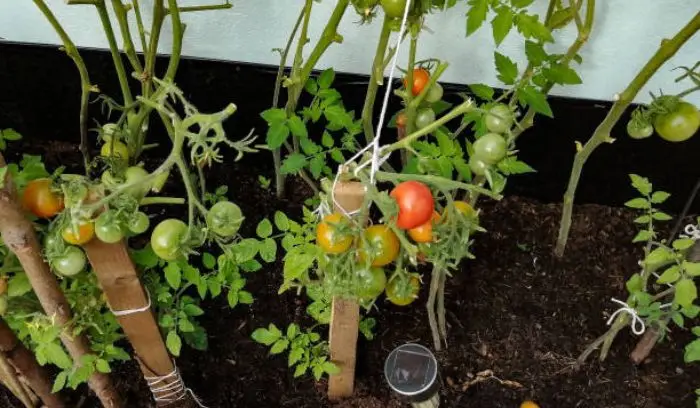
The soil must possess a slightly acidic pH, be loose in texture, and have good drainage properties. The best options are loam or sandy loam, but if your soil types are heavier, like heavy clay, you can amend the soil with sand, sawdust, or peat moss to improve drainage.
Regular fertilizer is essential, especially one labeled for tomatoes. Make sure to fertilize throughout the season and follow the label instructions for best results.
After 50 to 65 days of planting, you’ll start to see your tomatoes change color from green to shades of orange, red, yellow, or even purple, depending on the variety. Once the tomatoes are ripe, they will easily detach from the stem, signaling that they are ready for harvest. Be sure to check your plants regularly for harvestable fruit. If left too long, over-ripe tomatoes can split, rot, and eventually fall to the ground.
Light
Cherry tomatoes need full sun to grow well and thrive. They generally require six to eight hours of direct sun exposure each day to produce healthy, tasty fruits. In regions with harsh summer heat, it’s also beneficial to provide them with some afternoon shade.
This way, they can avoid the stress of extreme temperatures while still getting the essential light they need to thrive. In my experience, balancing light exposure carefully helps your plants grow strong and gives you a better harvest.
Although full sun is best, it’s important to monitor how your plants react. If they’re exposed to too much heat, they might show signs of stress. Providing some afternoon shade can be a simple solution to help the plants manage heat better, ensuring that they continue to grow without facing burnout during those long, hot days.
Soil
For cherry tomatoes to grow well, you need slightly acidic, well-drained soil. The best type of soil is loamy dirt, which is a mix of silt, clay, and sand. If your soil has too much heavy clay, it can be challenging for the plants, so it’s a good idea to amend the ground with materials like compost or sand.
Alternatively, you can use container plants if the natural environment isn’t ideal. Before planting, make sure to test the soil’s nutrient levels and pH to ensure it’s healthy for your plants. This helps provide the necessary nutrients for growing and ensures the produce will thrive.
When it comes to growing cherry tomatoes, it’s crucial to ensure that the soil isn’t too compacted or overly dry. Keep it well-drained, and make adjustments if needed. Proper soil care will lead to healthy plants and a productive harvest of these delicious fruits.
Water
Cherry tomato plants require consistent moisture in the soil to thrive. Too little moisture can lead to wilting, while too much can leave the roots soggy and susceptible to diseases. It’s important to water your plants properly—generally, garden tomatoes need about 1 to 2 inches of water each week. The amount may vary depending on the weather conditions and plant size. For example, during drought or summer heat, you may need to water more to prevent dry soil and issues like blossom-end rot or fruit splitting.
To water effectively, consider using drip irrigation, especially when the plants are young. This method reduces the force of streams that could cause soil erosion. As your tomatoes grow and become mature plants, water them deeply and consistently to avoid moisture swings.
Ensuring that the soil stays evenly moist will help prevent any stress on the plants, especially during hotter periods when excessive moisture fluctuations can harm their development.
Temperature And Humidity
When growing cherry tomatoes, it’s important to ensure the temperatures are just right. These plants are not cold-hardy, so you should wait until the final frost has passed before planting them outdoors.
Temperatures should remain above 60° F to encourage healthy growth. In areas with high humidity, moderate temperatures between 70° to 80° are ideal for promoting strong development and good fruit production. Warmer temperatures might actually slow down harvest growth, so it’s best to maintain a balance.
In Southern climates, cherry tomatoes can even be grown as a fall crop or winter crop. This flexibility makes them a great option in warmer areas. Whether you’re growing them during the warmer months or extending your harvest into the cooler seasons, adjusting to the right temperature and humidity levels is key to a successful crop.
Fertilizer
For healthy cherry tomatoes, using a high-phosphorus fertilizer is essential, especially when you’re planting them. This type of fertilizer is specifically designed for tomatoes, so be sure to choose a fertilizer labeled for tomatoes to ensure it meets their specific needs.
After the initial planting, it’s important to continue to fertilize the plants throughout the season, following the label instructions carefully. This will assist them in developing robustly and yielding an abundant harvest.
In addition to fertilizer, adding compost to your soil can also be a great way to amend it. This helps improve the soil structure and adds valuable nutrients. Just make sure that the soil is well-prepared and balanced so that your cherry tomatoes can thrive and produce the best possible yield.
Types Of Cherry Tomatoes
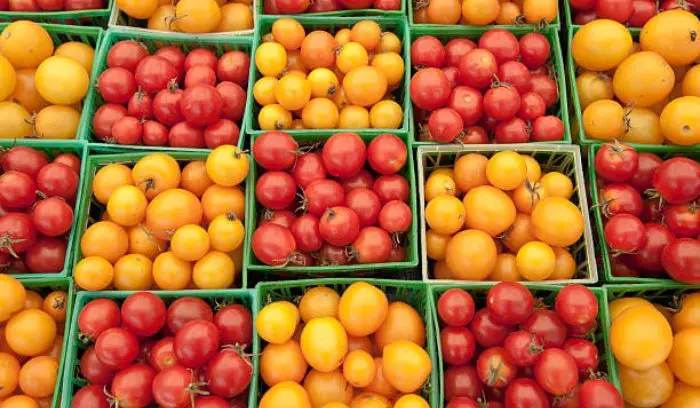
Black Cherry
The Black Cherry variety is known for its dark red tomatoes, though they can sometimes appear yellow or orange. These tomatoes have a unique flavor, offering a blend of sweet, tangy, and slightly smokey notes, making them a favorite in many gardens.
As they grow, Black Cherry tomatoes become quite tall and will definitely need a support cage to help them stand strong and healthy. This variety of tomato can produce an abundant crop, but it needs the right care and environment to thrive.
When you choose to grow Black Cherry, be prepared for a plant that will grow tall and need some extra attention.
The support cage is essential as it helps support the weight of the vines and fruit. It’s a variety that produces vibrant, flavorful fruit with an appearance that occasionally appears in shades of both red and orange, adding beauty to your garden while giving you delicious, smokey-flavored tomatoes.
Yellow Pear
The Yellow Pear is a unique tomato variety that stands out due to its pear-shaped appearance. This variety is easily recognized by its bright yellow color, making it a beautiful addition to any garden or dish. The mild flavor, paired with a subtle citrus undertone, makes it a refreshing choice for salads, sauces, and even snacking.
In terms of appearance, the Yellow Pear is small, often resembling little pears, and it grows in clusters. This delightful variety can add a bit of sweetness and tanginess to your meals, offering a distinctive flavoring that sets it apart from more common tomatoes. If you’re looking for something different, this tomato variety is a fantastic choice.
Sweet Treats
When growing Sweet Treats, you’ll notice that this indeterminate plant produces small, yet flavorful tomatoes. The fruit itself is a rich deep pink color, offering a taste that closely resembles a full-sized tomato, but with a more concentrated sweetness. It’s a treat for anyone who loves tomatoes but prefers a smaller bite-sized version with a robust flavor. These tomatoes can be enjoyed fresh in salads, on sandwiches, or even as a topping for dishes that need a burst of freshness.
As the plant matures, you’ll be amazed at how it continues to yield produce over a long period, making it a favorite among gardeners. Whether you’re a beginner or experienced grower, these tomatoes are perfect for anyone looking to add something unique to their garden with an easy-to-care-for variety.
Sun Gold
The Sun Gold tomato is an indeterminate variety, meaning it will continue to produce fruit throughout the growing season. As it ripens, the tomato will first turn a beautiful golden yellow, but it’s important to wait until it turns orange before harvesting. The extra time gives the tomato a chance to fully develop its unique flavor.
When you finally bite into a Sun Gold, you’ll experience a sweet, sugary taste with hints of tropical flavor, making it a favorite for those who enjoy a burst of sweetness in their tomatoes. It’s perfect for snacking, salads, or adding to a variety of dishes where you want to bring in that light, refreshing taste.
Midnight Snack
The Midnight Snack tomato is a special variety of cherry tomato that needs to be caged as it grows. As the tomatoes ripen, they will turn a beautiful shade of indigo when exposed to the sun. This unique color change makes them easy to spot in your garden, but it’s important to let them ripen fully before harvesting.
What makes these tomatoes even more interesting is their nutritional value. They contain antioxidants similar to those found in blueberries, which are great for your health. In terms of taste, Midnight Snack tomatoes offer a balance of sweet and savory flavors, making them perfect for snacking or adding to your favorite dishes.
Common Problems With Cherry Tomatoes
Leaves Turning Yellow
One of the common issues with cherry tomatoes is leaves turning yellow. This can be caused by whitefly infestations, which spread the tomato yellow leaf curl virus. This virus can damage the fruit yield and affect the overall health of the plant. Infected weeds nearby can also be a source of the problem. Symptoms of the virus include foliage that curls up and turns yellow, leading to weaker plants. As the disease progresses, it can even result in smaller foliage and stunted growth, which limits the plant’s ability to produce fruit.
To deal with this issue, it’s important to remove infected portions of the plant to stop the spread of the disease. You can also use insecticidal soap or horticultural oil to help stop the infestation and control the whitefly problem. Taking these steps can protect your plants and keep them healthy throughout the growing season.
Leaves Turning Black/Brown
If you notice your cherry tomato plants have leaves turning black or brown, it could be a sign of a serious problem like buckeye rot or late blight. These diseases are often caused by a fungus that spreads quickly.
Infected plants show spotted brown foliage, and if left untreated, the disease can consume the entire fruit plant. This problem tends to occur more frequently in warm temperatures, and poorly drained soil only makes it worse.
To treat these issues, it’s important to improve air circulation around your plants and make sure the soil is well-draining.
If the problem persists, you may need to apply a fungicide or copper spray to stop the fungus and prevent further damage. Regularly monitoring your plants can help catch problems early and keep your tomatoes healthy.
Fruit Splitting
Fruit splitting is a common issue with cherry tomatoes. This happens when the skin of the tomato cracks or splits due to a sudden change in the plant’s water supply. If the plant experiences a rapid change in moisture, the fruit can become stressed and split open. While some varieties of tomatoes are more resistant, this problem can affect most plants if the watering routine isn’t consistent.
To prevent fruit splitting, it’s essential to maintain proper irrigation and follow a consistent watering schedule. This helps to avoid sudden moisture changes. Using a calcium-infused fertilizer can also strengthen the tomato skin, reducing the likelihood of splits. This simple care routine can make a big difference in ensuring a healthy and bountiful tomato harvest.
FAQs
Tomatoes can be determinate or indeterminate in their growth habit. Determinate tomato plants grow to a certain height, then stop, flower, and set fruit quickly in a short period. They produce all their fruit at once.
In contrast, indeterminate tomato plants grow, flower, and set fruit continuously throughout the growing season, giving a longer harvest. The choice between the two depends on the type of harvest and available space.
Cherry tomato plants thrive in warm conditions, with the ideal soil temperature ranging from 60°F to 85°F (15°C to 29°C). For the best growth, plant them when the soil is within this temperature range to ensure healthy, strong plants.
Maintaining these temperatures, along with proper sunlight and water, will help your tomatoes thrive and produce a great harvest.
Cherry tomato plants are usually indeterminate, meaning they have a large, sprawling growth habit and need pruning and support. If space is limited, many gardeners opt for determinate varieties, which grow in a compact, bush-like shape and are easier to manage in small spaces.
Choosing between the two depends on the space and growing method you prefer. Indeterminate plants require more care, while determinate varieties are more space-efficient.
around three to four months. After this period, the plant finishes its growth, produces fruit, and eventually dies.
This quick lifecycle is one of the reasons why cherry tomatoes are so popular for home gardeners. You can grow and enjoy a full crop in just a few months, making them a perfect option for those who want fast results.
Grape tomatoes and cherry tomatoes are different in a few ways. Grape tomatoes are less watery and more oval, while cherry tomatoes are round and juicier. Additionally, cherry tomatoes have a shorter shelf life than grape tomatoes.
Though both are sweet, their texture and longevity set them apart.
Yes, cherry tomatoes can grow indoors in the winter. Start them from seed or a propagated stem cutting in a well-draining container with potting soil. Use a garden lamp to provide adequate light.
To protect the plants from pests, apply organic insecticidal soap. With the right care, you can enjoy fresh tomatoes even in winter.
Cherry tomatoes and larger varieties should be stored at room temperature on the counter for up to five days if they need to ripen. Once they are ripe or over-ripe, you can move them to the fridge for up to two weeks. Avoid refrigerating them before they ripen, as this will cause them to lose flavor.
Cherry tomatoes are packed with antioxidants like vitamin C and lycopene, which can help improve immunity and support overall health. They also aid in lowering blood pressure and cholesterol. You can easily add them to your diet by using them in salads, toasts, or even jams.
I love incorporating cherry tomatoes into my meals for a healthy boost of flavor and nutrients. They’re versatile and easy to use in many recipes.
See Also:
What Do Carrots Look Like When They Start to Grow
How Long Does It Take for Bell Peppers to Grow?
Do Daylilies Spread? (And If So, How Fast?)
Is It Illegal to Pick Spanish Moss in Florida? Everything You Need to Know


